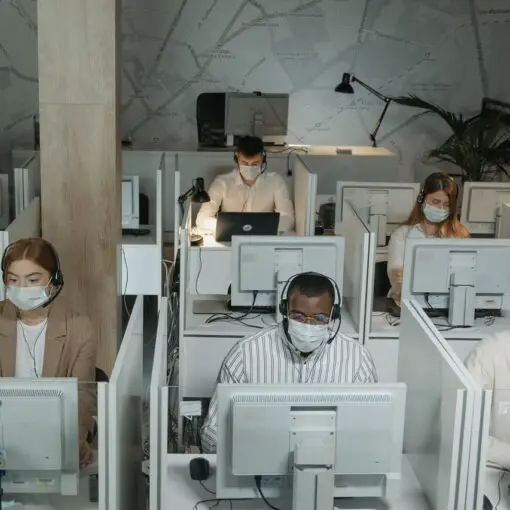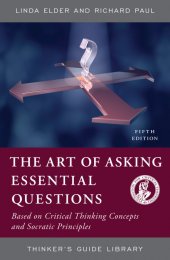
- Search Search Search …
- Search Search …

10 Critical Thinking Questions to Ask in Any Situation: Enhance Your Decision-Making Skills

Critical thinking is an essential skill in today’s information-heavy world. It helps individuals navigate through vast amounts of data and determine what is accurate and useful. This article aims to provide you with key questions that can be used in any situation to enhance your critical thinking abilities.

Asking the right questions can empower you to evaluate information effectively and make better decisions. Whether it’s assessing news articles, evaluating work presentations, or deciding on personal matters, these questions will guide your thought process . By incorporating these into your daily routine , you can sharpen your analytical skills and gain a clearer understanding of various topics.
1) What are the underlying assumptions?

Underlying assumptions are beliefs we accept without proof. These can shape our decisions and views. They often go unnoticed yet influence our thoughts and actions significantly.
In critical thinking , recognizing these assumptions is crucial. They might be hidden but can affect how we understand information. For example, thinking all teenagers are tech-savvy is an assumption that might not always be true.
Assumptions can be based on personal experiences, cultural norms, or societal expectations. These assumptions can lead to bias if not examined. Challenging them helps in forming a clearer, more unbiased perspective.
A critical thinker asks what assumptions are being made. They evaluate if these beliefs are real or just presumed. By questioning underlying assumptions, one can uncover hidden biases and make more informed decisions.
For more about identifying assumptions, visit Critical Thinking and Academic Research .
2) How relevant is this information to the issue?

Whenever one faces a problem or decision, assessing how relevant the information is to the issue is crucial. It’s about filtering out noise and focusing on what truly matters.
Relevance helps in narrowing down the data, ensuring that only useful details are considered. This prevents distractions and keeps problem-solving on track.
It’s vital to ask whether the information directly impacts the decision or if it’s just peripheral. Recognize which details support the objective and which ones do not.
Relevance also impacts the quality of decisions. Using relevant information ensures more accurate and reliable outcomes.
Evaluating relevance involves looking at the direct connection between the facts and the issue. It requires critical thinking and the ability to discern what’s important .
3) What are the possible consequences?
Thinking about possible consequences can help make better decisions. This involves anticipating both positive and negative outcomes of an action.
It is crucial to consider how a decision will affect various aspects of life. For example, a choice made at work can impact both professional reputation and personal well-being.
Considering consequences also means thinking about short-term and long-term effects. Some decisions might bring immediate benefits but lead to problems later. Balancing these factors helps avoid unwanted surprises.
Understanding potential consequences can guide towards more responsible actions. One way to do this is by asking, “If I do this, what might happen next?” This approach fosters careful and deliberate decision-making.
For instance, if a student decides not to study, the immediate consequence might be more free time. However, the long-term consequence could be poor grades. Recognizing this helps in making informed choices.
It’s also important to think about consequences for others. Actions can affect family, friends, and colleagues. By considering these impacts, one can act more ethically and thoughtfully.
In any situation, weighing possible consequences ensures a more comprehensive understanding of potential outcomes. It promotes a balanced approach and reduces the risk of negative results.
4) What evidence supports this claim?
When evaluating a claim, it’s important to ask for evidence. Evidence can include data, statistics, expert opinions, or firsthand experiences. This helps to verify the truthfulness of the statement.
Having solid evidence makes an argument stronger. For example, in academic settings, using evidence to support your argument is crucial. It helps to convince others of your point of view.
In discussions or debates, asking for evidence forces clearer thinking. This can prevent the spread of misinformation. According to Harvard University , identifying a claim and seeking evidence creates a more informed dialogue.
Always consider the source of the evidence. Reputable sources are more reliable. This ensures that the evidence is valid and trustworthy. By consistently asking for and examining evidence, you can improve your critical thinking skills effectively.
Can this viewpoint be challenged?
When considering any viewpoint, it’s crucial to ask if it can be contested. This question opens the door to examining the strength and validity of the perspective.
By challenging a viewpoint, one can explore potential weaknesses or flaws. This process is essential in critical thinking , as it encourages deeper analysis and understanding.
For instance, in a debate, questioning the opposition’s view helps identify any assumptions or biases. This scrutiny can lead to a more balanced and fair discussion.
Additionally, examining opposing viewpoints provides a broader perspective. Recognizing that multiple perspectives exist fosters a more comprehensive grasp of the topic.
Moreover, considering alternative views encourages flexibility in thinking. It helps individuals avoid rigid or narrow-minded approaches.
Encouraging students to question can promote critical inquiry in educational settings. Asking “Can this viewpoint be challenged?” engages students in active learning and reflection.
To summarize, always ask if a viewpoint can be challenged. This question is key in fostering thoughtful and informed discussions.
For more questions that foster critical thinking, such as analyzing the relevance of information, you can explore resources like TeachThought’s list of questions .
6) What Are the Alternatives?
When faced with a decision, it’s important to ask, “What are the alternatives?” This question encourages you to consider other options and not just stick to the first idea that comes to mind.
Exploring alternatives can reveal better solutions that might not have been obvious initially. It widens the scope of possibilities and helps in finding the best possible choice.
Sometimes, the best option isn’t the most convenient one. Asking about alternatives encourages more thoughtful decision-making. It ensures that all potential paths are evaluated.
Considering alternatives can also help identify any potential risks or benefits not initially evident. This leads to more informed and balanced decisions.
For instance, if a manager needs to improve team productivity, they shouldn’t just implement the first suggested tool. They should think about various tools and methods, comparing their pros and cons.
Asking “What are the alternatives?” is a habit of strong critical thinkers. It ensures they are not limited by initial impressions and are open to different perspectives.
Tools like brainstorming sessions and mind maps can be helpful in identifying and evaluating alternatives. These methods ensure a thorough exploration of all possible options.
7) Who benefits from this?
When examining a situation, it’s key to identify who stands to gain.
Understanding who benefits helps uncover motivations. For example, if a new policy is implemented, ask who benefits from this . It could be companies, individuals, or specific groups.
Looking at all angles can provide clarity. Different stakeholders may have varying benefits. Some might gain financially, while others might receive social or political advantages.
Knowing the beneficiaries can also reveal any potential biases. If a project benefits only a small group, it might not serve the wider community well.
This question is essential because it digs deeper into the heart of the issue. It gets to the core of why certain actions are taken and who is truly advantaged.
8) What are the sources of bias?
Bias can stem from many areas. Personal opinions and values are common sources. If a person holds strong beliefs, these can color their judgment and decision-making.
Preconceived notions also play a big role. When someone has a fixed idea about something, they may ignore new information that contradicts their belief.
Cognitive biases are another source. These are mental shortcuts that affect how people process information. The Khan Academy explains that these can lead to errors in thinking.
Social biases, like racism or sexism, come from societal influences. These explicit biases can affect how someone views and treats others based on group identity.
Unconscious biases are hidden preferences that influence decisions without awareness. These implicit biases can be just as powerful as explicit ones.
External influences such as media and peers can also introduce bias. News sources and social circles can shape opinions and views, often without one noticing.
Understanding these sources can help in recognizing and mitigating bias in decision-making.
9) Is the argument logically sound?
A crucial step in critical thinking is to check if an argument is logically sound. A sound argument is one that is both valid and has true premises. Valid arguments have a structure where the conclusion follows logically from the premises.
If any premise of an argument is false, the argument cannot be sound. This means that even if the logic is valid, the argument fails because it is based on incorrect information. It’s important to verify the truth of each premise before accepting the conclusion.
One way to practice this is by asking if the premises logically lead to the conclusion without any gaps. For example, an argument that states, “All humans are mortal. Socrates is a human. Therefore, Socrates is mortal,” is sound because both premises are true and lead to a logical conclusion.
When evaluating arguments, look for common fallacies. These can include ad hominem attacks, false dilemmas, or appeals to authority. For instance, claiming a law is unconstitutional because a friend, who is a lawyer, said so might be an example of a fallacy .
In summary, ensuring an argument is logically sound involves checking both the validity of its structure and the truth of its premises. This helps in making informed decisions based on reliable reasoning.
10) What is the context of this situation?
Understanding the context of a situation is crucial for effective decision-making. Context includes the background and framework within which events occur. It helps identify the relationships between different elements in a scenario.
Context can include historical background. This involves looking at past events that might influence the current situation. Knowing what has happened before can provide insight into why things are the way they are now.
Another aspect of context is the environment. This means understanding the physical, social, or cultural setting. For example, a decision in a corporate environment may differ greatly from one made in a community-based setting.
Stakeholder perspectives also define the context. Understanding who is affected by the situation and what their interests are can guide more empathetic and effective choices. This includes considering the opinions, motivations, and potential biases of everyone involved.
Economic factors can be part of the context as well. Financial constraints or incentives often play a role in shaping decisions. Understanding the monetary aspects can lead to more informed and practical outcomes.
Lastly, legal and ethical considerations are essential. Rules, laws, and ethical norms provide boundaries within which decisions must be made. Ignoring these can lead to negative consequences.
Knowing the context ensures that decisions are not only well-informed but also sensitive to the broader environment and potential impacts. This comprehensive understanding can lead to better, more sustainable outcomes.
The Importance of Critical Thinking
Critical thinking is essential because it enhances decision-making and problem-solving skills. It impacts both personal growth and career development by fostering informed opinions and objective analysis.
Why Critical Thinking Skills Matter
Critical thinking allows individuals to analyze and break down complex issues. By asking better questions, people can make more informed decisions. It involves understanding and evaluating information rather than just accepting it. This skill helps in identifying biases and making logical connections. According to the Harvard Business Review , critical thinking is at the heart of problem-solving, enabling individuals to tackle challenges efficiently.
Impact on Personal and Professional Life
In personal life, critical thinking improves self-awareness and reduces limitations set by negative beliefs. This leads to better decision-making and a higher quality of life, as noted by the University of the People . Professionally, it is crucial for the economy and enhances skills like communication and presentation. Being able to think critically means considering all options and their potential impacts, which is valuable in any career. This approach leads to well-informed opinions and effective problem-solving strategies, making individuals indispensable in their fields.
Applying Critical Thinking in Various Contexts
Applying critical thinking helps individuals analyze information and make better decisions. It is useful in different areas such as work, education, and everyday life.

Critical Thinking at Work
In the workplace, critical thinking can improve problem-solving. Employees who evaluate situations carefully often find effective solutions. For instance, a manager might assess the root cause of a decline in sales before deciding on a strategy. This helps in making informed decisions.
Critical thinking also aids in teamwork. When team members question and discuss ideas, they develop better plans. For example, during a project, brainstorming sessions benefit from diverse opinions. This approach ensures that the final plan is robust and well-thought-out.
Employers value critical thinkers. These employees can foresee potential issues and address them proactively. They contribute to a more efficient and innovative work environment. Companies benefit from having staff who can handle complex situations thoughtfully.
Critical Thinking in Education
In education, critical thinking enhances learning. Students who question assumptions and analyze texts develop deeper understanding. For instance, when studying historical events, they evaluate causes and consequences, leading to a more comprehensive grasp of history.
Teachers encourage critical thinking through discussions and problem-based learning. Rather than just memorizing facts, students engage with the material. This active participation helps them retain information and apply it in real-world situations.
Critical thinking prepares students for future challenges. By learning to think critically, they become better equipped to tackle complex problems. This skill is essential for success in higher education and future careers.
Everyday Decision Making
Critical thinking is valuable in daily life. It helps individuals make better personal decisions. For example, before buying a product, a person might research reviews and compare prices. This careful evaluation ensures that they get the best value.
In health-related choices, critical thinking is crucial. Evaluating medical advice and considering all options lead to better health outcomes. For instance, understanding the benefits and risks of a medical procedure helps in making informed decisions.
It also aids in resolving conflicts. By considering different perspectives, individuals can find peaceful solutions. Critical thinking fosters empathy and understanding, making personal interactions more harmonious.
Enhancing Your Critical Thinking Abilities
Improving your critical thinking skills involves developing specific techniques and overcoming barriers that can hinder your progress.
Techniques for Improvement
One effective way to boost critical thinking is by asking open-ended questions. This can help uncover deeper insights and encourage detailed responses. Questions like “Why do you think this happened?” or “What are the possible outcomes?” can stimulate deeper thought.
Another technique is to engage in active listening. Focus on understanding the speaker’s point of view and consider the context before forming an opinion. This practice helps in evaluating information accurately.
It’s also useful to practice problem-solving regularly. Tackle puzzles, play strategy games, or engage in debates. These activities train the mind to think critically under different scenarios.
Finally, maintain a habit of continuous learning. Staying informed on various topics broadens your perspective, making it easier to analyze situations from multiple angles.
Overcoming Common Barriers
A major obstacle to critical thinking is cognitive bias. These biases can cloud judgment and lead to poor decisions. Being aware of common biases like confirmation bias or anchoring can help you recognize and counteract them.
Stress and time constraints can also hinder critical thinking. Practicing stress management techniques such as meditation or time management can create a more conducive environment for thoughtful analysis.
Another barrier is the lack of confidence. To overcome this, focus on building self-assurance through practice. Engaging in group discussions or seeking feedback can provide different perspectives and boost confidence.
Lastly, an unwillingness to challenge assumptions can impede critical thinking. Commit to questioning existing beliefs and explore alternative viewpoints, allowing for a more comprehensive understanding of any situation.
You may also like

What Is Drone Mentality?
Drone mentality is a pattern of going through the motions, paying little to no attention to what’s going on around you. Think […]

5 Activities that Will Teach Children about Critical Thinking
Teaching your children to dig deeper and solve problems with a higher level of thinking can be tough. But as a parent, […]

Critical Thinking & Language Learning
From a very young age, learning a language is of utmost importance. Starting from our mother tongue, we then learn another language […]

Advanced Critical Thinking Strategies: Elevate Your Problem-Solving Skills
Critical thinking is more important than ever in today’s fast-paced world. Advanced strategies can help individuals not just in making decisions but […]
- Thinker's Guides

The Art of Asking Essential Questions (Based on Critical Thinking Concepts and Socratic Principles)
Fifth edition, linda elder and richard paul, order from rowman & littlefield here., contact info for rowman & littlefield:.
- Toll free: (800) 462-6420 ext. 3024
- Fax: (800) 338-4550
- Orders to [email protected]
- Queries to [email protected]
Additional Information About: The Art of Asking Essential Questions (Based on Critical Thinking Concepts and Socratic Principles)
Normal 0 false false false EN-US X-NONE X-NONE MicrosoftInternetExplorer4
The quality of our lives is determined by the quality of our thinking. The quality of our thinking, in turn, is determined by the quality of our questions, for questions are the engine, the driving force behind thinking. Without questions, we have nothing to think about. Without essential questions, we often fail to focus our thinking on the significant and substantive.
When we ask essential questions, we deal with what is necessary, relevant, and indispensable to a matter at hand. We recognize what is at the heart of the matter. Our thinking is grounded and disciplined. We are ready to learn. We are intellectually able to find our way about.
To be successful in life, one needs to ask essential questions: essential questions when reading, writing, and speaking; when shopping, working, and parenting; when forming friendships, choosing life-partners, and interacting with the mass media and the Internet.
Yet few people are masters of the art of asking essential questions. Most have never thought about why some questions are crucial and others peripheral. Essential questions are rarely studied in school. They are rarely modeled at home. Most people question according to their psychological associations. Their questions are haphazard and scattered.
The ideas we provide are useful only to the extent that they are employed daily to ask essential questions. Practice in asking essential questions eventually leads to the habit of asking essential questions. But we can never practice asking essential questions if we have no conception of them.
This mini-guide is a starting place for understanding concepts that, when applied, lead to essential questions. We introduce essential questions as indispensable intellectual tools. We focus on principles essential to formulating, analyzing, assessing, and settling primary questions. You will notice that our categories of question types are not exclusive. There is a great deal of overlap between them. Deciding what category of question to ask at any point in thinking is a matter of judgment. Having a range of powerful questions to choose from is a matter of knowledge.
Contents include:
- Questioning the Structure of Thinking
- Asking One System, No System, and Conflicting System Questions
- Questioning Dogmatic Absolutism and Subjective Relativism
- Questioning Concepts
- Questioning Data, Information, and Experience
- Questioning Questions: Identifying Prior Questions
- Asking Complex Interdisciplinary Questions
- Questioning in Decision-Making and Problem-Solving
- Evaluative Questions
- Determining Value, Merit, and Worth
- Evaluating Reasoning
- Questioning As We Read
- Questioning As We Write
- Questioning Within Academic Disciplines
- Essential Questions in Science
- Essential Questions in the Social Disciplines
- Essential Questions in the Arts
- Questioning for Self-Knowledge and Self-Development

Critical Thinking: What It Is and Why It Matters
Defining critical thinking dispositions and why they’re crucial..
Posted September 23, 2024 | Reviewed by Devon Frye
- Another way to think about and measure critical thinking is to include aspects of motivational dispositions.
- Dispositions include open-mindedness and a willingness to be reflective when evaluating information.
- People scoring low in critical thinking dispositions tend to “keep it simple” when something is complex.
- Critical thinking dispositions help individuals avoid oversimplification and can facilitate awareness of bias.
Critical thinking springs from the notion of reflective thought proposed by Dewey (1933), who borrowed from the work of philosophers such as William James and Charles Peirce. Reflective thought was defined as the process of suspending judgment, remaining open-minded, maintaining a healthy skepticism, and taking responsibility for one’s own development (Gerber et al., 2005; Stoyanov & Kirshner, 2007).

Kurland (1995) suggested, “Critical thinking is concerned with reason, intellectual honesty, and open-mindedness, as opposed to emotionalism, intellectual laziness, and closed-mindedness. Thus, critical thinking involves… considering all possibilities… being precise; considering a variety of possible viewpoints and explanations; weighing the effects of motives and biases; being concerned more with finding the truth than with being right…being aware of one’s own prejudices and biases” (p. 3). Thus, being able to perspective-take and becoming conscious of one’s own biases are potential benefits of critical thinking capacities.
Reviews of the critical thinking literature (e.g., Bensley, 2023) suggest that the assessment of this construct ought to include aspects of motivational dispositions. Numerous frameworks of critical thinking dispositions have been proposed (e.g., Bensley, 2018; Butler & Halpern, 2019; Dwyer, 2017); some commonly identified dispositions are open-mindedness, intellectual engagement, and a proclivity to take a reflective stance or approach to evaluating information and the views and beliefs of both oneself and others. Demir (2022) posited that critical thinking dispositions reflect persons’ attitudes toward and routine ways of responding to new information and diverging ideas, willingness to engage in nuanced and complex rather than either/or reductionistic thinking, and perseverance in attempts to understand and resolve complex problems.
Other examples of dispositions are inquisitiveness, open-mindedness, tolerance for ambiguity, thinking about thinking, honesty in assessing or evaluating biases, and willingness to reconsider one’s own views and ways of doing things (Facione et al., 2001). Individual personality attributes associated with these proclivities include a need for cognition (a desire for intellectual stimulation), which is positively associated with critical thinking, and the need for closure (a motivated cognitive style in which individuals prefer predictability, firm answers, and rapid decision making ) and anti-intellectualism (a resentment of “the life of the mind” and those who represent it), both negatively associated with critical thinking.
Further, an ideological component that can impede critical thinking is dogmatism . In addition, rigid, dichotomous thinking impedes critical thinking in that it oversimplifies the complexity of social life in a pluralistic society (Bensley, 2023; Cheung et al., 2002; Halpern & Dunn, 2021) and tries to reduce complicated phenomena and resolve complex problems via “either/or” formulations and simplistic solutions.
In other words, folks with low critical thinking dispositions would tend to “keep it simple” when something is really quite complicated, and think it absolute terms and categories rather than seeing “the gray” in between the black and white extremes.
In sum, critical thinking dispositions are vitally important because they may help individuals avoid oversimplifying reality; they also permit perspective-taking and can facilitate their awareness of diversity and systematic biases, such as racial or gender bias . Some research has indicated that critical thinking dispositions uniquely contribute to academic performance beyond general cognition (Ren et al., 2020), and may help to reduce unsubstantiated claims and conspiracy beliefs (Bensley, 2023; Lantian et al., 2021).
But before we can study the potential impact of critical thinking dispositions, it is necessary to have a reliable, valid, and hopefully brief measure for this construct. I will discuss the development and validation of a measure of critical thinking dispositions in another post.
Bensley, D.A. ( 2023.) Critical thinking, intelligence, and unsubstantiated beliefs: An integrative review. Journal of Intelligence, 1 , 207. https://doi.org/10.3390/jintelligence11110207
Bensley, D.A. (2018). Critical thinking in psychology and everyday life: A guide to effective thinking . New York: Worth Publishers.
Butler, H.A., & Halpern, D.F. (2019). Is critical thinking a better model of intelligence? In Robert J. Sternberg (Ed.) The Nature of Intelligence (pp. 183–96). Cambridge: Cambridge University Press.
Cheung, C.-K, Rudowicz. E., Kwan, A., & Yue, X.. (2002). Assessing university students’ general and specific criticalthinking. College Student Journal, 36 , 504 – 25.
Demir, E. (2022). An examination of high school students’ critical thinking dispositions and analytical thinking skills. Journal of Pedagogical Research, 6 , 190–200. https://doi.org/10.33902/JPR.202217357
Dewey, J. (1933). How we think: A restatement of the relation of reflective thinking to the educative process . Lexington: Heath and Company.
Dwyer, C. P. (2017). Critical thinking: Conceptual perspectives and practical guidelines . Cambridge: CambridgeUniversity Press.
Facione, P., Facione, N,C,, & Giancarlo, C.A.F. (2001(. California Critical Disposition Inventory . Millbrae: California Academic Press.
Gerber, S., Scott, L., Clements, D.H., & Sarama, J. (2005). Instructor influence on reasoned argument in discussion boards. Educational Technology, Research & Development, 53 , 25–39. https://doi.org/10.1007/BF02504864
Halpern, D. F., & Dunn, D.S. (2021). Critical thinking: A model of intelligence for solving real-world problems. Journal of Intelligence, 9 , 22. https://doi.org/10.3390/jintelligence9020022
Kurland, D. (1995). I know what it says… What does it mean? Critical skills for critical reading . Belmont: Wadsworth.
Lantian, A., Bagneux, V., Delouvee, S., & Gauvrit, N. (2021). Maybe a free thinker but not a critical one: High conspiracybelief is associated with low critical thinking ability. Applied Cognitive Psychology, 35 , 674 – 84. https://doi.org/10.1002/acp.3790
Ren, X., Tong, Y., Peng, P. & Wang, T. (2020). Critical thinking predicts academic performance beyond general cognitiveability: Evidence from adults and children. Intelligence, 82 , 101487. https://doi.org/10.1016/j.intell.2020.101487
Stoyanov, S., & Kirschner, P. ( 2007). Effect of problem solving support and cognitive styles on idea generation:Implications for technology-enhanced learning. Journal of Research on Technology in Education, 40 , 49–63. https://doi.org/10.1080/15391523.2007.10782496

Kyle D. Killian, Ph.D., LMFT is the author of Interracial Couples, Intimacy and Therapy: Crossing Racial Borders.
- Find a Therapist
- Find a Treatment Center
- Find a Psychiatrist
- Find a Support Group
- Find Online Therapy
- United States
- Brooklyn, NY
- Chicago, IL
- Houston, TX
- Los Angeles, CA
- New York, NY
- Portland, OR
- San Diego, CA
- San Francisco, CA
- Seattle, WA
- Washington, DC
- Asperger's
- Bipolar Disorder
- Chronic Pain
- Eating Disorders
- Passive Aggression
- Personality
- Goal Setting
- Positive Psychology
- Stopping Smoking
- Low Sexual Desire
- Relationships
- Child Development
- Self Tests NEW
- Therapy Center
- Diagnosis Dictionary
- Types of Therapy

When we fall prey to perfectionism, we think we’re honorably aspiring to be our very best, but often we’re really just setting ourselves up for failure, as perfection is impossible and its pursuit inevitably backfires.
- Emotional Intelligence
- Gaslighting
- Affective Forecasting
- Neuroscience
